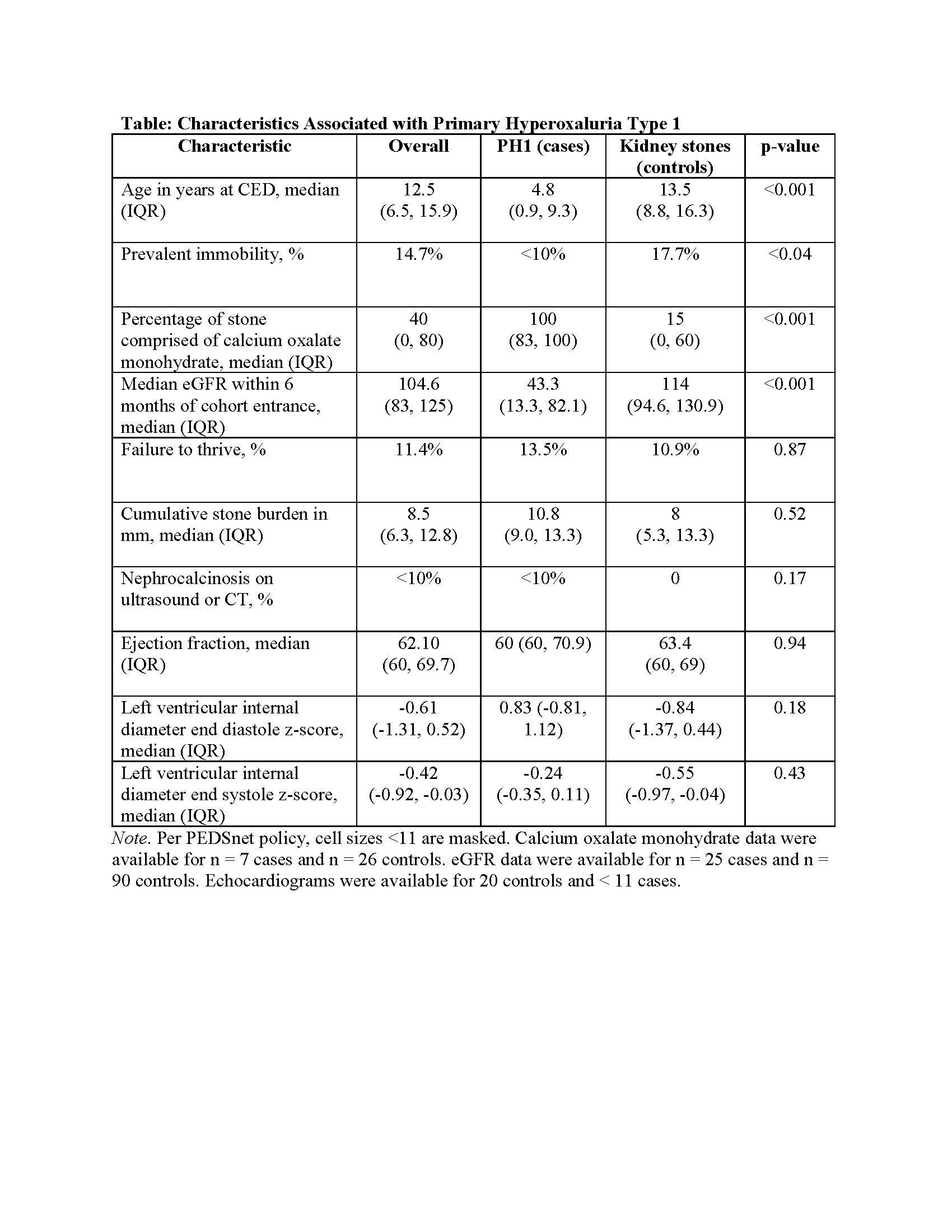Back
Introduction: Primary hyperoxaluria type 1 (PH1) is an ultra-rare disorder of hepatic overproduction of oxalate that causes early onset kidney stones, chronic kidney disease, and systemic oxalosis. We sought to identify defining clinical characteristics of children with PH1 in order to develop approaches that facilitate its early diagnosis.
Methods: We determined the association between patient-level characteristics of PH1 in a case-control study conducted between January 2009 and August 2021 in PEDSnet, a clinical research network of eight pediatric health systems in the United States. We matched each patient with confirmed PH1 to 4 control patients with kidney stone disease not due to PH1 by sex and PEDSnet site at date of diagnosis (cohort entrance date). We obtained patient characteristics and diagnostic test results occurring before to less than 6 months after cohort entrace from a centralized query of the data pooled from the electronic health records and from manual chart review at each PEDSnet site. Differences in patient characteristics and diagnostic test results between patients were compared using paired tests as appropriate for the distribution of and type of data.
Results: The study sample included 37 patients with PH1 and 147 controls. Compared to patients with kidney stone disease not due to PH1, patients with PH1 were younger, were less likely to have immobility, had a higher percentage of stone comprised of calcium oxalate monohydrate, and had a lower eGFR measured within 6 months of cohort entrance (Table). There were no statistically significant differences in prevalent diagnosis of failure to thrive, cumulative stone size on ultrasound, nephrocalcinosis on ultrasound or CT, or echocardiography results.
Conclusions: In this study, children with PH1 were characterized by presentation before adolescence, absence of immobility, high percentage of calcium oxalate monohydrate stone composition, and decreased eGFR at diagnosis. If validated in external populations, these consortium of characteristics may enable a strong clinical suspicion for PH1 diagnosis, facilitating confirmatory testing, and facilitating initation of targeted therapeutics. SOURCE OF
Funding: Alnylam Pharmaceuticals

Moderated Poster Session
Session: MP16: Stone Disease: Epidemiology & Evaluation I
MP16-08: Distinguishing Characteristics of Children with Primary Hyperoxaluria Type 1 in PEDSnet
Friday, April 28, 2023
1:00 PM – 3:00 PM CST
Location: S405
- GT
Gregory E. Tasian, MD
Associate Professor of Urology and Epidemiology
The Children's Hospital of Philadelphia
Poster Presenter(s)
Introduction: Primary hyperoxaluria type 1 (PH1) is an ultra-rare disorder of hepatic overproduction of oxalate that causes early onset kidney stones, chronic kidney disease, and systemic oxalosis. We sought to identify defining clinical characteristics of children with PH1 in order to develop approaches that facilitate its early diagnosis.
Methods: We determined the association between patient-level characteristics of PH1 in a case-control study conducted between January 2009 and August 2021 in PEDSnet, a clinical research network of eight pediatric health systems in the United States. We matched each patient with confirmed PH1 to 4 control patients with kidney stone disease not due to PH1 by sex and PEDSnet site at date of diagnosis (cohort entrance date). We obtained patient characteristics and diagnostic test results occurring before to less than 6 months after cohort entrace from a centralized query of the data pooled from the electronic health records and from manual chart review at each PEDSnet site. Differences in patient characteristics and diagnostic test results between patients were compared using paired tests as appropriate for the distribution of and type of data.
Results: The study sample included 37 patients with PH1 and 147 controls. Compared to patients with kidney stone disease not due to PH1, patients with PH1 were younger, were less likely to have immobility, had a higher percentage of stone comprised of calcium oxalate monohydrate, and had a lower eGFR measured within 6 months of cohort entrance (Table). There were no statistically significant differences in prevalent diagnosis of failure to thrive, cumulative stone size on ultrasound, nephrocalcinosis on ultrasound or CT, or echocardiography results.
Conclusions: In this study, children with PH1 were characterized by presentation before adolescence, absence of immobility, high percentage of calcium oxalate monohydrate stone composition, and decreased eGFR at diagnosis. If validated in external populations, these consortium of characteristics may enable a strong clinical suspicion for PH1 diagnosis, facilitating confirmatory testing, and facilitating initation of targeted therapeutics. SOURCE OF
Funding: Alnylam Pharmaceuticals

